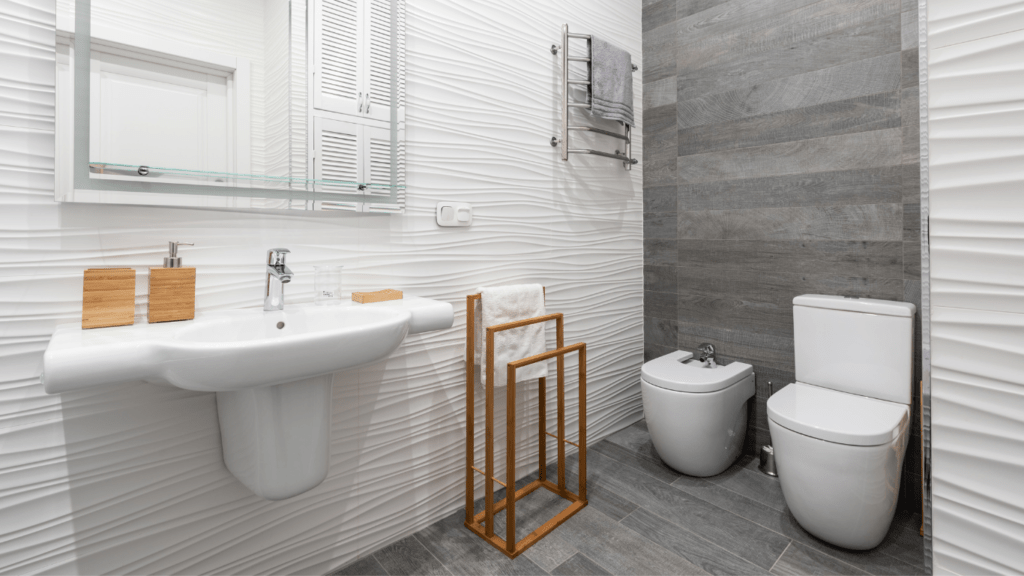Assessing Your Space
Before diving into a bathroom renovation, understanding the space is crucial. Evaluating dimensions and potential hurdles ensures a smooth process.
Measuring Properly
Accurate measurements dictate the success of a renovation. Begin by measuring the length, width, and height of the bathroom. Note the:
- location of doors
- windows
- existing fixtures like sinks and toilets
Use a digital tape measure for precision. Document all measurements in a notebook or a digital app for easy reference. Include even minor details, like protruding pipes, to avoid surprises later.
Identifying Potential Issues
Spotting potential problems early can save time and money. Inspect walls and floors for signs of water damage, mold, or mildew. Check the plumbing for leaks or outdated pipes that might need replacing. Also, look for electrical issues like outdated wiring or insufficient outlets. If structural issues are evident, consult a professional for further evaluation. Documenting these issues helps in planning the renovation more effectively.
Planning Your Renovation
It’s crucial to have a clear plan when starting a bathroom renovation, especially in small spaces. Planning avoids common pitfalls and ensures a smoother process.
Setting a Budget
Allocating a budget sets the foundation for the project. I start by listing all necessary expenses, such as fixtures, tiles, and labor. Including a contingency of around 10-15% covers unexpected costs. Researching average costs in your area provides a realistic budget estimate. Using a spreadsheet keeps all expenses organized and updated.
Choosing a Design Theme
A cohesive design theme enhances the bathroom’s visual appeal. I suggest exploring minimalist, contemporary, or rustic themes. Each offers unique elements that can be adapted to small spaces. For example, a minimalist theme uses clean lines and neutral colors, making the space feel larger. Gathering inspiration from design magazines and online platforms helps refine the theme.
Selecting the Right Materials
Choosing durable and moisture-resistant materials is essential. I prefer ceramic or porcelain tiles for their durability and ease of maintenance. High-quality fixtures, such as stainless steel or chrome faucets, prevent rust and wear. Eco-friendly materials, like recycled glass tiles, add sustainability to the renovation. Consulting with suppliers ensures the materials fit both the budget and design theme.
Maximizing Space with Smart Storage Solutions
Efficient storage transforms small bathrooms into organized and functional spaces. Here are practical tips for making the most of limited room.
- Built-In Shelving
Built-in shelving optimizes wall space by providing essential storage without crowding the area. Incorporating shelves into recesses reduces visual clutter and maintains a streamlined look. Use narrow shelving units in unused corners or behind the door for toiletries. Opt for adjustable shelves to accommodate items of varying sizes.
- Floating Vanities
Floating vanities provide storage while maintaining an open floor space. These vanities attach to the wall, creating a spacious feel by exposing the floor beneath. Select models with drawers or open shelves to store essentials. Floating vanities also simplify cleaning and provide a modern, minimalist appearance -
Over-Toilet Storage
Over-toilet storage maximizes vertical space above the toilet. Install cabinets or shelves in this often-neglected area to keep toiletries accessible. Choose slender units to avoid making the bathroom feel cramped. Over-toilet cabinets with closed doors can conceal clutter, maintaining a tidy environment.
Incorporating Multi-Functional Fixtures

Maximizing small bathroom spaces often involves clever fixture choices. Multi-functional fixtures save space and enhance usability.
Dual-Function Showers and Tubs
Dual-function showers and tubs offer flexibility. These fixtures allow you to enjoy both a quick shower and a relaxing bath without needing separate installations. For instance, a shower-tub combo with sliding glass doors can make a small bathroom feel less cramped. Manufacturers like Kohler offer units with built-in shelving for added convenience. When selecting such fixtures, ensure they fit well within your existing layout and consider models with built-in storage to further maximize space.
Combination Mirrors and Cabinets
Combination mirrors and cabinets provide storage and functionality. These fixtures merge a mirror with a cabinet, allowing you to store toiletries within arm’s reach while saving wall space. For example, I installed a mirrored cabinet above the sink, which concealed my everyday essentials and kept the countertop clutter-free. Brands like IKEA offer sleek designs that fit various bathroom styles. Choose models with adjustable shelves to customize the storage according to your needs.
Enhancing Lighting and Ventilation
In small bathroom renovations, lighting and ventilation are critical elements that impact functionality and comfort. Effective lighting and proper ventilation can make a small space feel larger and more inviting.
Natural Light Maximization
Natural light isn’t just an aesthetic boost; it’s crucial for a welcoming atmosphere. Use frosted or textured glass for privacy without sacrificing light. Installing a skylight or solar tube adds overhead light in windowless bathrooms. Reflective surfaces, like tiles and mirrors, help distribute natural light throughout the space.
Optimal Ventilation Techniques
Proper ventilation prevents mold and mildew. Install a high-quality exhaust fan with adequate CFM (cubic feet per minute) ratings based on your bathroom’s size. Position the fan near the shower or tub for maximum effectiveness. Consider models with humidity and motion sensors that activate as needed. Opening windows during and after showers can also enhance airflow and reduce moisture.
Adding Finishing Touches
The final touches can transform a small bathroom renovation. Attention to detail with colors and accessories completes the space.
Color Palette Choices
Choosing the right color palette impacts the bathroom’s perceived size and ambiance. Light colors, such as whites, soft grays, and pastels, make spaces look larger and more inviting. For instance, a pastel blue wall paired with white tiles creates a serene environment. Also, monochromatic schemes reduce visual clutter. Use different shades of a single color like varying tones of beige for depth. Accents of bold colors can add contrast and interest without overpowering the space—think navy towels or a single red wall art piece. Reflective surfaces like glossy tiles and mirrors enhance the light, brightening the room.
Accessory Selection
Selecting the right accessories adds personality and functionality. Opt for space-saving items that serve multiple purposes. Choose slim-profile towel racks and hooks to efficiently use wall space. Storage baskets under the sink or stylish containers on shelves help organize toiletries neatly. Mirrors with built-in lighting not only save space but improve illumination. Coordinated accessories, such as matching soap dispensers and toothbrush holders, create a cohesive look. Plants, like small succulents, add a natural element, instilling freshness without consuming much space.



 Betsylie Sheetsin – Home Renovation Expert
Betsylie Sheetsin serves as the Home Renovation Expert at Castle Shelf House, specializing in giving practical advice for both small and large-scale home improvements. With years of experience in construction and renovation, Betsylie understands the importance of blending durability with design. Her insights into home renovation projects, along with expert advice on the latest materials and techniques, empower homeowners to tackle even the most ambitious projects confidently.
Betsylie Sheetsin – Home Renovation Expert
Betsylie Sheetsin serves as the Home Renovation Expert at Castle Shelf House, specializing in giving practical advice for both small and large-scale home improvements. With years of experience in construction and renovation, Betsylie understands the importance of blending durability with design. Her insights into home renovation projects, along with expert advice on the latest materials and techniques, empower homeowners to tackle even the most ambitious projects confidently.
